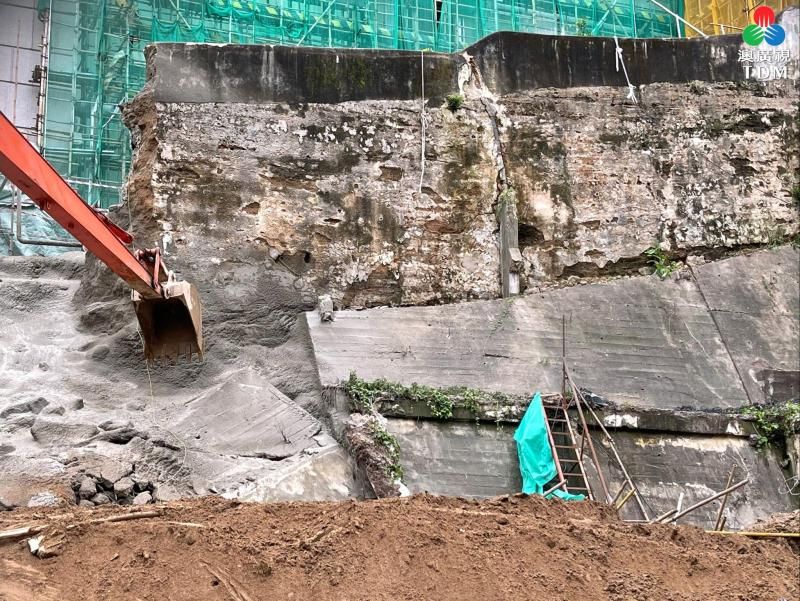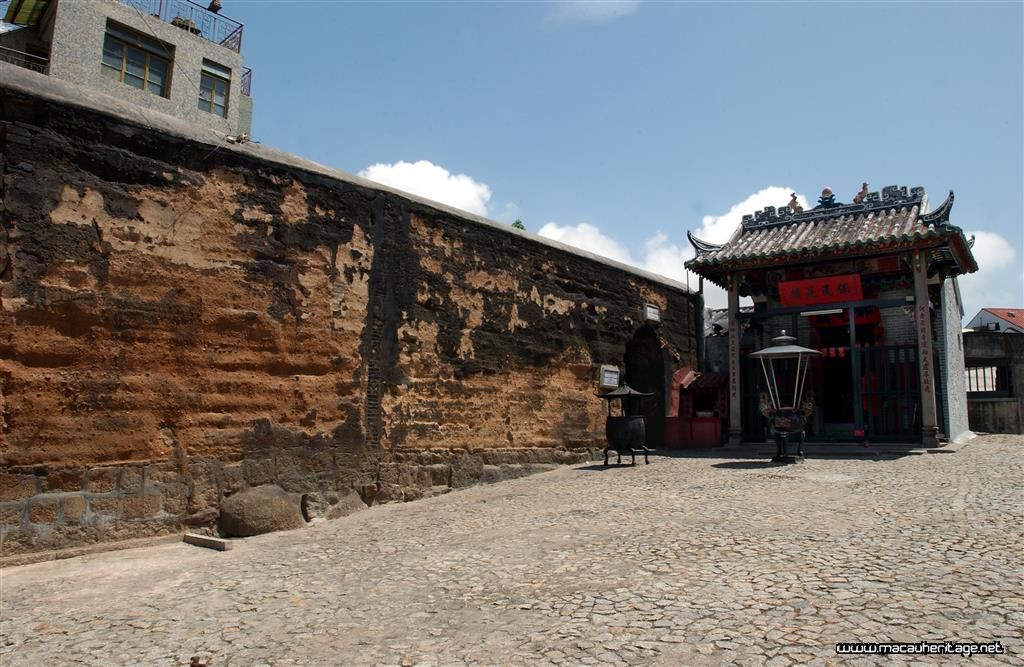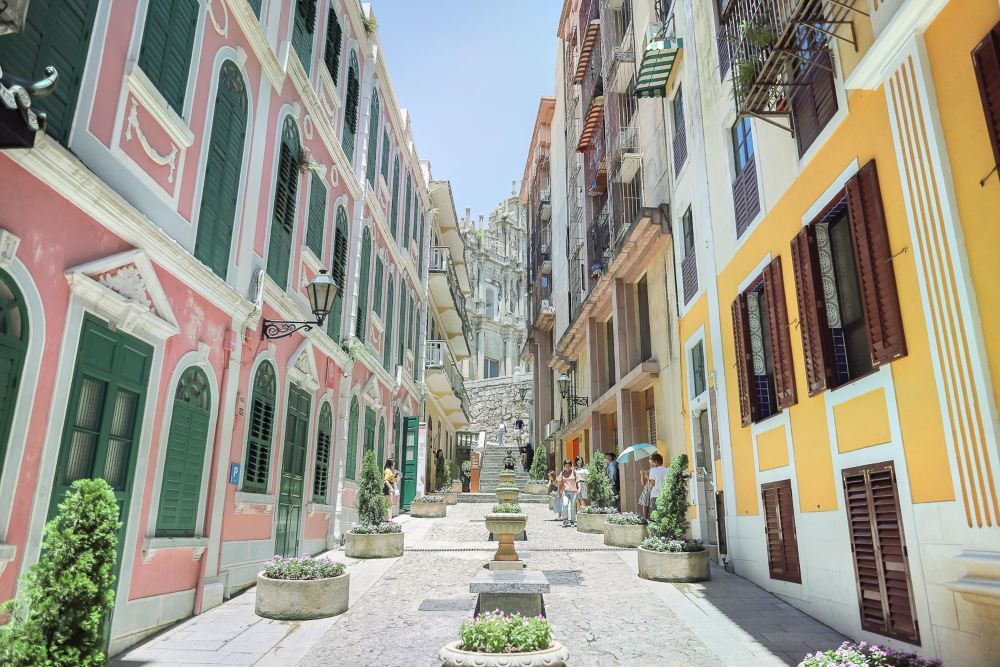
澳門90後|社會科學碩士|財經媒體|澳門研究| 生活瑣事
After the Fall of the Walls: The Politics and Tensions of Relics and Conservation
Author: Diaoyu Lang from the Far East (trying to study the two sides of history with social science methods)
In the past month, Macau has been plagued by misfortunes: in addition to the haze of the outbreak, there has also been a catastrophic accident at a local historical site. The incident happened at a construction site adjacent to the Garthlan Garden, where the 17th century ancient city wall was excavated. At the beginning of the month, due to landslides, more than one-third of the city wall collapsed . After the collapse, the government further decided to demolish the 10-meter city wall on the grounds of "public safety" , so that the old ruins, which were originally 50 meters long, suddenly remained about two-fifths of their original length within a month.

In addition to once again highlighting the "always-occurring" problems in Macau, including who is responsible among government departments, and the hasty approval to start construction without detailed geological and historical investigations, the irony is that even if The city wall has long been included in the government's "Real Estate Assessment" list, and theoretically has a certain degree of institutional protection, but in the end it is inevitable that it will be destroyed.
The fate of the ancient city wall is in stark contrast to its status as one of Macau's important historical "relics". For "us", the city wall is a "living record" of Macau's history, with cultural and even emotional value to the local community. Therefore, "we" expect it to require a certain degree of protection so that it can survive in the future.
Although the above definition seems reasonable, if we examine it in depth, it turns out that the relationship between "heritage" and "preservation" is not so clear at a glance. Taking the opportunity of the "City Wall Incident", in this article, I will use the research of cultural heritage scholar Trinidad Rico in 2015, combined with the local context, to examine the complex meaning behind the use of "ruins" to refer to specific things.
Ruins are dangerous
The reason why "relics" are "relics" is of course related to their long past. As things left over from the "old times", the ruins naturally exist in various conditions that are different from the "original appearance" due to various human and natural influences. While brick by brick may be inconspicuous, once things become "relics", these otherwise unappreciated differences immediately become quite important.

This is so because "relics" themselves are also a system of classification. By rating buildings on a series of indicators, these buildings then acquire the attribute of their "vulnerability" and further classify them into the same system. As a result, a set of different levels (such as "risky", "endangered") and a "relic" system that regards "risk" as a judgment thing came into being.
Therefore, when a building becomes a "relic" and thus acquires a certain "objective" attribute, it will further derive a specific cultural right that can "legitimately" claim that it should be protected.
We can imagine a counter-example: if the city wall itself is not a "real estate" assessed by the government, but just a pile of bricks and tiles on a hillside, then whether it is public concern or the government's conservation responsibility, it will be because of its "no name and no name". surname” and was ignored, perhaps buried long ago by the ruthless hand of the bulldozer. It is precisely because it has become something that "should" be preserved that the social repercussions are so obvious.
Seemingly objective but subjective
Although the heritage system that classifies things according to "risk" seems to be straightforward, classifying and quantifying the degree and urgency of its need to be protected, it is so "objective and clear" and "universal" ", is only part of the story.
Because when we say that a relic is "at risk", we are essentially referring to a phenomenon that occurs in a specific space-time context. In the actual operation, the evaluation process already includes various subjective evaluation components.
As mentioned above, when the government decides to demolish a part of the city wall due to the risk of "public safety", it involves a series of issues related to the risk, such as what does the "risk" include (the safety of the residents of the adjacent buildings? A Safety of passers-by on construction sites that are inaccessible to idlers?)? Under what circumstances is there a risk (only after a landslide?)? And the level of risk (need instant disassembly?) etc.
What these questions involve is, in fact, a huge space for subjective judgment.
To complicate matters, the way in which these questions are answered is further influenced by a variety of political and cultural factors. If we look back at the past and present life of Macau's "City Wall Incident", we can find that even as early as 2015, the City Wall has become a member of the "real estate" list, but for a long time, the ancient city wall and construction sites Described as "harmonious coexistence", the risk is either (perceived) non-existent at the time or to the extent that no action is required.
It is only when the walls are brought down by "external forces" that "risk" resurfaces (although for the government, the perception of "risk" and the specific actions against it happen to be in opposite directions).
Therefore, the example of the city wall shows us that the ruins were inherently quite political. On the one hand, although there is indeed a system for the protection of relics in Macau, in terms of specific implementation, the “habitual habits” of the Macau bureaucracy have made the system empty, and the risk has become a showground for departments to shirk each other. .
On the other hand, it is quite paradoxical that, as Zhihui discussed in the previous article , the reason why the city wall can be regarded as a "relic" is of course related to its long history. However, the reason why the "long" history is highly valued in Macau is also closely related to the political and economic implications of "relics" in Macau.
a particular view of conservation
If the concept of "relics" already has a certain degree of complexity, then the concept of "conservation" is actually not too conceited. Taking the city wall as an example, when we say that the city wall needs "conservation", we actually mean: the buildings of the old era have been damaged to varying degrees due to various factors. Therefore, how to maintain or even restore its "original" appearance as much as possible is an urgent task at present.
But "keeping the original appearance" is actually just one of the ways to reflect the value of the heritage. In the discussion of heritage conservation, there is also a completely different view, which is to regard artificial restoration as an act of destroying the heritage. From this point of view, the reason why relics are valuable is precisely because of the combination and stacking of various man-made traces at different time points in history, creating “relics” as a carrier for “recording” the past. Artificially "returning the relics to their original state" will cause irreversible effects of the relics.
An example that the author thinks of that may not fit the background of the above discussion, but is quite interesting, is the "graffiti group" in Love Lane next to the archway of the St. Paul's. As a member of the same class of assessed real estate, Love Lane or because the street name is quite "romantic", many people have "marked" here to commemorate it. Over time, it has gradually formed a graffiti wall in a corner of the street.

Undoubtedly, these "graffiti" have destroyed the original appearance of the alley, but from another perspective, these "love" records just reflect the meaning of the street name (and the meaning of "Suffering Alley" that really conforms to its original meaning, I After all, many of the relationships have long since expired), which unexpectedly adds to the fun of stopping and watching during the tour.
From the above examples, we can see that even in the face of the same relic, the two conservation discourses in the way of looking at the relic can actually draw completely different conclusions. The reason for this is that "conservation" itself is a concept that contains many ambiguities and values, and these values and concepts, like "relics", are also affected by specific temporal-spatial backgrounds.
Values that we take for granted today were not always the case.
never again
If the meaning of "relics" and "conservation" can be properly understood only by returning to the local context, then the situation in Macau can be described as a combination of two extremes:
An afterthought but a self-defeating government, and old buildings with a long history that are not valued.
The fate of the remaining city walls is still unknown, but at the time of writing, Macau is about to experience its first typhoon this year, and I hope it will not be the last straw that overwhelms the city walls.
#Number of articles: 1️⃣1️⃣8️⃣
✅ Patreon |👍Facebook Page |📣 Call for Papers |👂 Podcast
Like my work?
Don't forget to support or like, so I know you are with me..

在帝國邊陲講故事

四個社會科學和歷史背景的作者,嘗試訴說一座名叫「澳門」的看不見的城市。它的故事不止關乎自身,也關乎背後的帝國和邊陲。 👇我們的故事|Podcast|免費電子報|Patreon https://linktr.ee/macaology_empire
Comment…